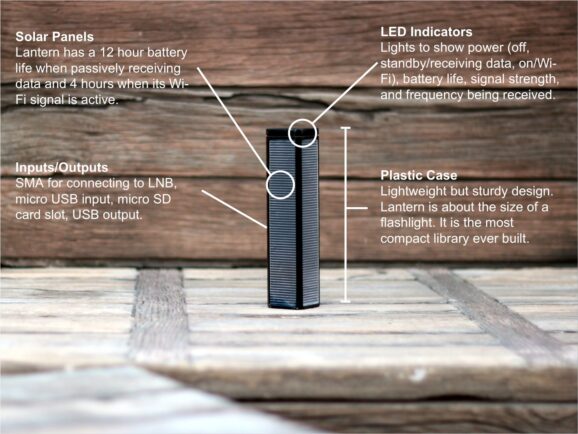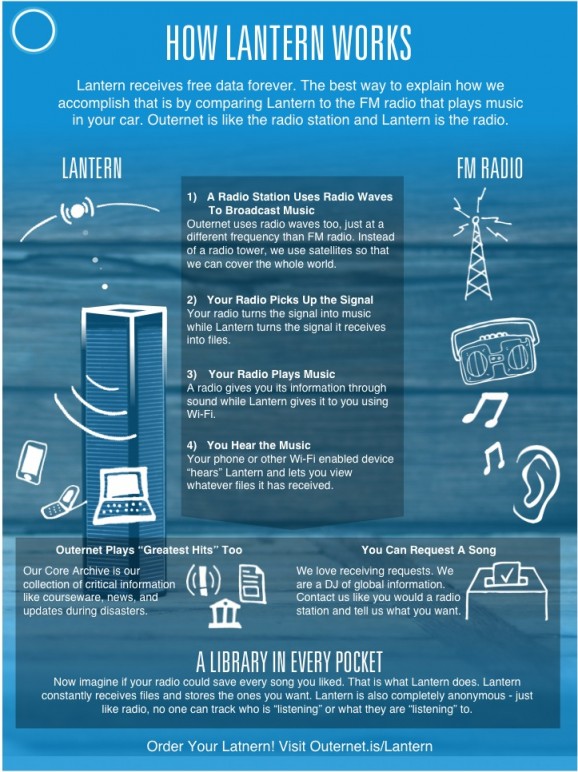Want Free Data From Space? Check Out The Lantern
This article is more than 2 years old
 It seems like everyone’s jumping on the “internet for everyone” bandwagon these days. But what about people who live in places where the government censors or blocks connections? And what about the data-mining, information-harvesting pitfalls associated with the internet? And what about the costs? The answer may be something called Outernet, a free information service that bills itself as “Humanity’s Public Library,” and its corresponding hardware, the “Lantern.”
It seems like everyone’s jumping on the “internet for everyone” bandwagon these days. But what about people who live in places where the government censors or blocks connections? And what about the data-mining, information-harvesting pitfalls associated with the internet? And what about the costs? The answer may be something called Outernet, a free information service that bills itself as “Humanity’s Public Library,” and its corresponding hardware, the “Lantern.”
The Lantern is currently in the midst of a successful Indiegogo campaign, having surpassed its $200,000 goal with more than two weeks left. The best way to think of the Outernet and Lantern is by likening it to a radio station and radio. Satellites send radio waves to Outernet, which functions like a radio station. Except instead of converting those waves into sound, it converts them into files, which are received, stored, and accessed on the Lantern, which essentially functions like a radio in that it presents the information to consumers. Thus, Lantern becomes a portable library that’s constantly updated with the data sent from satellites and the subsequent broadcast. Instead of simply playing sound, Lantern converts the signals into files of all types—music, videos, ebooks, webpages, etc. Someone with a Lantern can access the stored files via a device with WiFi.
 Outernet provides its services for free, and it’s anonymous—the information and files people choose to download from the Outernet can’t be tracked (or at least that’s what its inventors say). That’s because, as the L.A. Times points out, “Outernet is not the Internet,” largely because it functions like “two one-way streets, one between the user and Outernet, and one between Outernet and their satellites.” In a lot of ways, Outernet is a scaled-down, bare-bones version of the internet. It downloads files—for example, the 5,000 Wikipedia articles that it has been broadcasting since August—and saves them offline. Then, the satellite used at headquarters sends that data to the two geostationary satellites which currently provides access to all of Europe, North America, the Middle East, and North Africa. The satellite then transmits the information back down to Earth in the form of radio waves, where a Ku-band dish receives the transmission. It’s possible to access that data with a Raspberry Pi, or through something like the Lantern.
Outernet provides its services for free, and it’s anonymous—the information and files people choose to download from the Outernet can’t be tracked (or at least that’s what its inventors say). That’s because, as the L.A. Times points out, “Outernet is not the Internet,” largely because it functions like “two one-way streets, one between the user and Outernet, and one between Outernet and their satellites.” In a lot of ways, Outernet is a scaled-down, bare-bones version of the internet. It downloads files—for example, the 5,000 Wikipedia articles that it has been broadcasting since August—and saves them offline. Then, the satellite used at headquarters sends that data to the two geostationary satellites which currently provides access to all of Europe, North America, the Middle East, and North Africa. The satellite then transmits the information back down to Earth in the form of radio waves, where a Ku-band dish receives the transmission. It’s possible to access that data with a Raspberry Pi, or through something like the Lantern.
The content isn’t unlimited, and it’s updated weekly or biweekly. There’s a Core Archive of the most important information, including news and disaster updates, as well as educational matter. After that, there’s a queue of requests submitted and voted on by users. New content can be requested via Facebook, snail mail, Twitter, the Outernet website, and soon, text message. There’s also sponsored content, which is identified as such and costs money.
If a disaster brought down cell phone towers, we’d still have access to news via Outernet. Lantern is the portable device that makes that information, as well as the media and other downloaded content, available to users anywhere, anytime. Since millions of people across the globe still don’t have access to internet, Outernet may be a solution—they’ll be trying it out in Namibia and South Sudan early next year. I love the idea of bringing information to everyone, rather than the internet to everyone. Time will tell whether this stripped-down approach will appeal to people with internet access, or whether it fills an information gap. Either way, I’m just glad this isn’t a Google or Facebook product.












